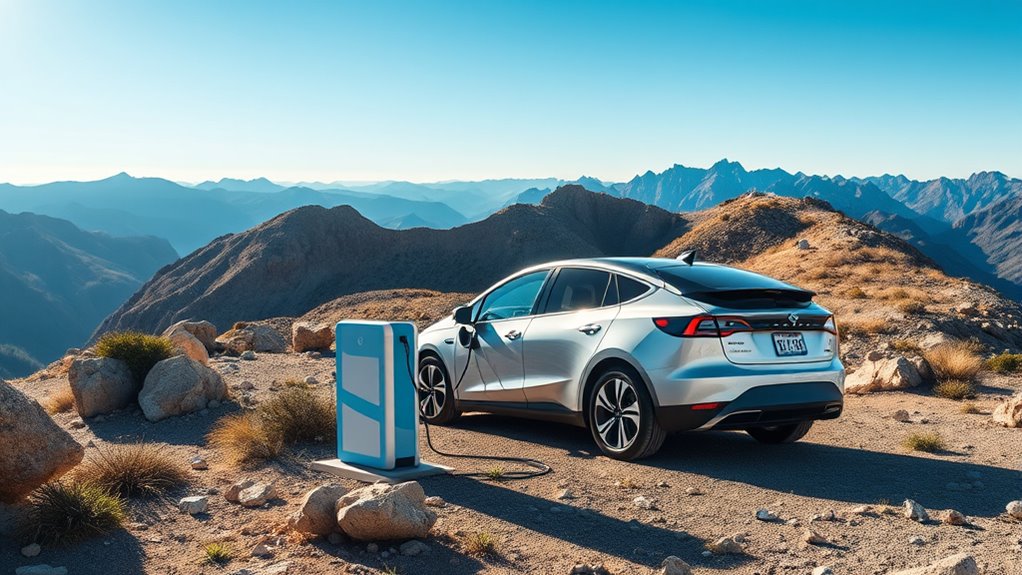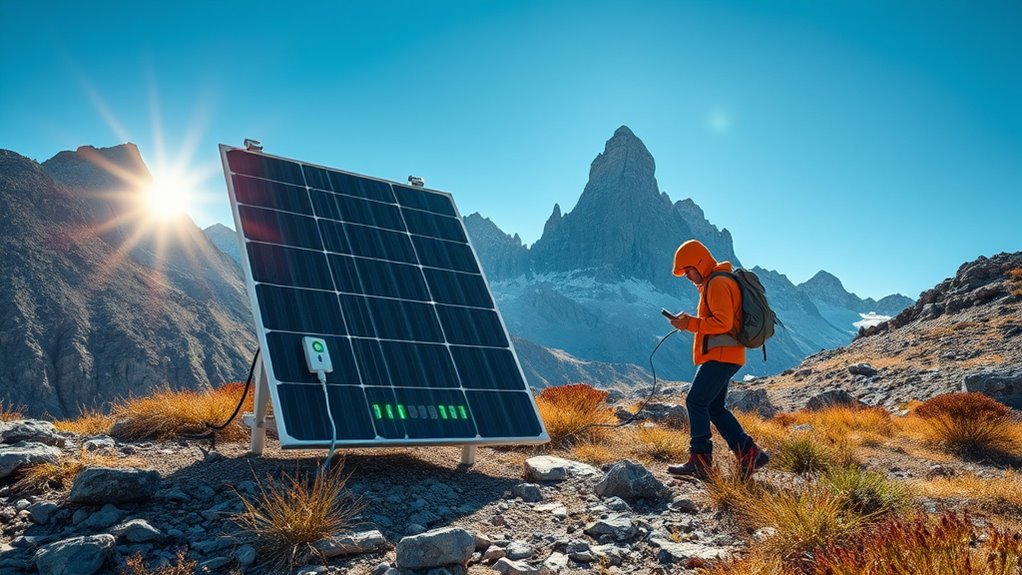In remote areas, fast charging becomes reliable and eco-friendly when powered by solar panels combined with battery storage. Solar arrays generate clean energy during the day, while batteries store excess power for use during cloudy conditions or at night. This setup reduces dependence on unstable grid connections and guarantees you can quickly recharge your EV whenever you need, even far from traditional stations. To discover how these systems work together and expand your travel possibilities, keep exploring.
Key Takeaways
- Solar-powered infrastructure combined with battery storage enables fast EV charging in remote areas without grid reliance.
- Dedicated solar farms and rooftop panels generate renewable energy for quick charging stations in isolated locations.
- Battery systems store excess solar power, providing consistent, on-demand energy for rapid EV charging during night or cloudy days.
- Integrated solar and storage solutions reduce charging time and increase reliability for remote EV travelers.
- Advances in scalable, affordable renewable energy systems support sustainable, fast charging infrastructure in underserved regions.

Remote areas often lack reliable charging infrastructure, making electric vehicle travel challenging. Without accessible charging stations, you might hesitate to venture into these regions, fearing your EV won’t have enough power to reach your destination. However, advancements in solar infrastructure and battery storage are transforming this landscape, enabling faster and more dependable charging solutions even in the most isolated locations.
Solar infrastructure plays an essential role in overcoming the limitations of traditional charging stations. By installing solar panels in remote areas, you can generate renewable energy directly where it’s needed. These solar arrays can be set up on rooftops, open land, or solar farms specifically designed for EV charging stations. As sunlight hits the panels, electricity is produced, providing a clean and sustainable power source. This setup not only reduces the dependency on grid connections, which may be unreliable or nonexistent in remote regions, but also guarantees you have access to energy during the day when sunlight is abundant.
Installing solar panels in remote areas provides reliable, clean energy for EV charging, reducing grid dependency and ensuring daytime power access.
But solar energy alone isn’t enough to guarantee seamless travel. That’s where battery storage comes into play. Battery storage systems act as a buffer, storing excess solar energy generated during sunny periods. When the sun isn’t shining—like at night or on cloudy days—you can draw from these batteries to charge your EV quickly. This combination of solar infrastructure and battery storage creates a self-sufficient charging ecosystem, allowing you to plan longer trips without worrying about finding a station or depleting your battery. You can charge up during the day and rely on stored energy later, giving you greater flexibility and confidence in remote areas.
Moreover, the integration of solar infrastructure and battery storage can facilitate fast charging solutions that are both eco-friendly and efficient. Fast chargers powered by solar and stored energy can deliver rapid top-ups, minimizing downtime during long trips. This setup ensures that you don’t have to wait long periods to recharge, making EV travel in remote regions more practical and appealing. As technology advances, these systems become more affordable and scalable, allowing communities and travelers alike to benefit from sustainable energy sources.
In essence, the pairing of solar infrastructure with battery storage is revolutionizing EV travel in remote areas. It provides a reliable, renewable power source that reduces dependence on traditional grids, enables fast charging, and opens up new possibilities for exploring less accessible regions. With these innovations, you no longer need to shy away from remote adventures—your electric vehicle can handle the journey, powered by the sun and stored energy, wherever your curiosity takes you.
Frequently Asked Questions
What Are the Environmental Impacts of Zero’s Charging Stations?
You might be concerned about the environmental impacts of Zero’s charging stations. They use renewable energy sources, which help reduce the ecological footprint and lower greenhouse gas emissions. By prioritizing clean energy, Zero minimizes pollution and resource depletion. However, manufacturing and installing stations still have some environmental effects, but overall, their focus on renewable energy makes these stations more eco-friendly compared to traditional fossil fuel options.
How Does Zero Ensure Safety in Remote Area Installations?
Did you know that over 90% of Zero’s remote area installations meet rigorous safety standards? To guarantee safety, you follow strict installation protocols that include thorough site assessments, advanced grounding techniques, and weather-resistant equipment. You also implement remote safety measures like remote monitoring and emergency shut-offs, making sure your charging stations are both reliable and safe, even in the most isolated locations.
What Is the Cost Comparison With Traditional Charging Methods?
You’ll find that Zero’s fast charging stations offer significant cost savings over traditional methods, mainly due to lower installation expenses and reduced maintenance costs. While initial setup might be slightly higher, the long-term savings are substantial because of efficient energy use and fewer repairs. Plus, faster charging means less downtime, helping you cut operational costs and improve overall efficiency in remote areas.
Are There Plans to Expand Zero’s Network Globally?
Yes, Zero plans a global expansion to enhance its network development worldwide. They’re actively working on establishing fast charging stations in remote areas, making EV charging more accessible everywhere. You can expect to see more stations popping up across different continents, ensuring you’re never far from a quick charge. This expansion aims to support your long-distance travels and promote cleaner, more sustainable transportation options globally.
How Does Zero Handle Power Outages or Technical Failures?
When power outages or technical failures occur, Zero relies on backup power systems to keep charging stations operational. You’ll find they follow strict maintenance protocols to quickly identify and resolve issues, minimizing downtime. These measures guarantee that even in remote areas, your charging needs are met reliably. Zero’s proactive approach helps you stay connected and confident, no matter the circumstances, so you can focus on your journey without worry.
Conclusion
With zero zones and swift solutions, you can conquer remote miles with confidence. Fast charging fuels your freedom, fueling future journeys and fostering full-fledged freedom. Embrace efficient energy, empower exploration, and eliminate exhaustion. By bridging barriers with bold breakthroughs, you become part of a powerful movement toward progress. So, seize the scene, stay charged, and stride into the sustainable side of adventure—because the future of remote travel depends on your drive!









